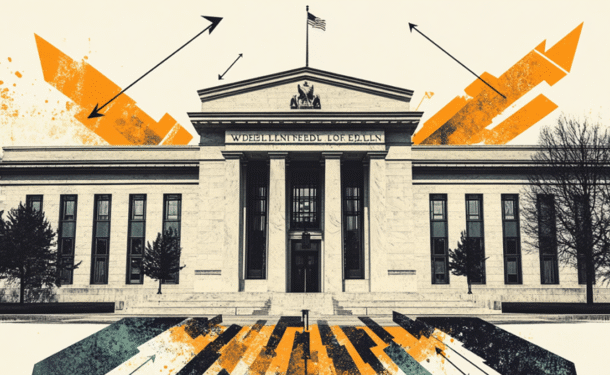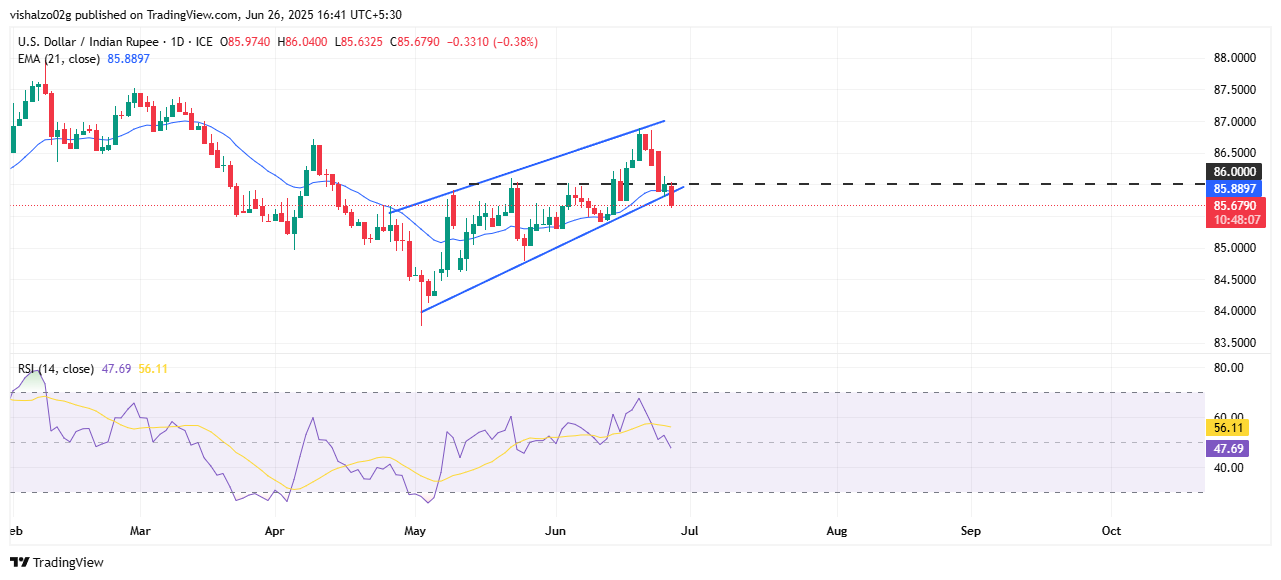
- The Indian Rupee strengthens as the US Dollar Index falls for the fourth straight session, hitting a fresh three-year low.
- US President Trump renews attacks on Fed Chair Powell, calls him “terrible,” and signals plans to name a replacement.
- Subdued Crude Oil prices and easing geopolitical tensions support the Rupee recovery from a three-month low.
The Indian Rupee (INR) trades stronger against the US Dollar (USD) on Thursday, buoyed by a sharp decline in the US Dollar Index (DXY), which tumbled to a fresh three-year low. The Greenback came under renewed pressure amid growing concerns over the independence of the Federal Reserve (Fed), following critical remarks from US President Donald Trump. Adding to the downward pressure were easing geopolitical tensions and subdued Crude Oil prices, both of which helped improve risk sentiment and support emerging market currencies, such as the Rupee.
Selling interest resurfaces in USD/INR, with the pair trading near 85.60 during American trading hours after a modest rebound the previous day. The pair is down roughly 0.45% and has breached below the 21-day Exponential Moving Average (EMA), suggesting a bearish outlook ahead.
Meanwhile, the US Dollar Index (DXY), which tracks the Greenback against a basket of six major currencies, remains under pressure, marking its fourth consecutive daily loss. The index is currently hovering near 97.20, its lowest level since February 2022.
The major factor driving the Rupee’s gains today is the sharp weakening of the US Dollar following renewed criticism of Fed Chair Jerome Powell by the US President Donald Trump. Speaking at a press conference after the NATO Summit in The Hague, Trump called Powell “terrible,” accused him of being “very political,” and reiterated his call for interest rate cuts. Trump also confirmed he is considering “three or four” possible replacements for Powell, whose term ends in May 2026. The remarks have amplified concerns about political interference in US monetary policy, undermining investor confidence in the Fed’s independence and weighing heavily on the Greenback.
Market Movers: Rupee gains on Fed uncertainty, Oil decline, Equity surge
- The Indian Rupee, which had come under pressure during the Iran-Israel conflict and slipped to a three-month low of 86.89 last week, is staging a strong recovery following the ceasefire, reclaiming levels seen before the escalation amid easing geopolitical tensions.
- Subdued Crude Oil prices are offering relief to the Indian Rupee, with WTI trading near $64.70 and Brent around $66.80 — both down roughly 12% so far this week. The sharp pullback, driven by the Iran-Israel ceasefire and easing supply concerns, has improved India’s import outlook and reduced external pressure on the currency.
- On the Equity front, the Sensex soared over 1,000 points to close at 83,755, while the Nifty jumped 304 points to end at 25,549 — both gaining 1.21%. The sharp rally boosted investor confidence, with market capitalization on the BSE surging by ₹3.33 lakh crore to ₹457.33 lakh crore, further supporting sentiment around the Rupee.
- While the Rupee has recently gained ground against a weaker US Dollar, it remains one of Asia’s worst-performing currencies this year. A mix of global headwinds — including global tariff tensions and geopolitical uncertainty — along with domestic challenges like persistent FII outflows, a negative net international investment position (NIIP), and a widening trade deficit, continues to weigh on the currency.
- Former RBI Governor and ex-chairman of the Prime Minister’s Economic Advisory Council, C. Rangarajan, has cast doubt on India’s ability to achieve the $5 trillion economy target by 2025, calling it “an aspirational goal” that doesn’t align with current growth dynamics. “People have been talking about India becoming a $5 trillion economy by 2025. Today, our GDP is close to $2.7 trillion. Therefore, reaching $5 trillion is almost close to doubling our GDP,” he said, implying that the existing pace of economic expansion may not be sufficient to meet this ambitious milestone within the projected timeline.
- On the US side, President Donald Trump’s repeated criticism of the Fed continues to rattle markets. His central complaint is that interest rates remain too high, which he claims is hampering growth and inflating government debt costs. Trump has argued that with inflation under control, rates should be 2–3 percentage points lower, citing moves by the European Central Bank and warning that delays could stall the US economy.
- US President Donald Trump doubled down on his stance during recent remarks, stating, “We have no inflation. We have a tremendous economy. Hundreds of billions of dollars of tariff money is pouring in. Factories are being built.” He further claimed that nearly $15 trillion in investment was flowing into the US. While pushing for aggressive rate cuts, Trump acknowledged that if inflation were to rise significantly, he would support future rate hikes.
- According to the Wall Street Journal, President Trump is considering announcing his preferred choice for Federal Reserve Chair as early as September or October. Reported contenders include former Fed Governor Kevin Warsh, NEC Director Kevin Hassett, current Fed Governor Christopher Waller, and Treasury Secretary Scott Bessent.
- In recent congressional testimony, Fed Chair Jerome Powell defended the central bank’s cautious policy approach amid rising political scrutiny. While he acknowledged that recent inflation data has moderated, Powell warned that Trump’s proposed tariffs could add upward pressure on prices in the coming months. He reaffirmed that the Fed’s actions will remain data-dependent and aligned with its dual mandate of stable prices and maximum employment, rather than being influenced by politics. “We always do what we think is the right thing to do, and we live with the consequences,” Powell stated, underscoring the Fed’s commitment to institutional independence.
- Mixed US Macro Data Clouds Fed Outlook: Data released today revealed that Core PCE rose 3.5% QoQ in Q1, up from 3.4% previously and sharply higher than the 2.6% seen in Q4 2024, signaling persistent inflation and complicating the Fed’s rate cut trajectory. At the same time, the US economy contracted by 0.5% annualized in Q1, marking the first quarterly decline in three years, as high interest rates dampened consumer spending and business investment. Meanwhile, initial jobless claims fell to 236,000, beating the consensus of 245,000 and reflecting continued labor market resilience despite broader signs of economic softening.
Technical analysis: USD/INR breaks rising wedge, bias turns bearish

The breakdown in the USD/INR pair marks a notable shift in outlook after weeks of orderly gains within a rising wedge formation. The pair’s failure to hold above the 21-day EMA, coupled with a clear breach of the wedge pattern support, has triggered technical selling. Currently hovering around 85.67, the pair appears vulnerable as the former support level near 86.00 has now turned into resistance, capping upward attempts. This breakdown follows a textbook reversal pattern that often precedes deeper pullbacks.
The Relative Strength Index (RSI) has dropped sharply from near overbought territory and is currently at 47.69, below the neutral 50 mark, indicating fading bullish momentum. If the pair fails to reclaim the 86.00–85.90 zone, the next level of support lies near 85.00, followed by the 84.40 region, which aligns with previous swing lows from early June. On the upside, only a decisive daily close above 86.00-86.20 would negate the current bearish structure and reopen the path toward 86.90–87.00 levels. For now, the bias remains bearish as the pair confirms a technical breakdown from a key wedge pattern.
(This story was corrected on June 26 at 13:41 GMT to clarify that the Core PCE reading refers to the quarterly data from the GDP report, not the Fed’s preferred monthly inflation gauge.)
Indian economy FAQs
The Indian economy has averaged a growth rate of 6.13% between 2006 and 2023, which makes it one of the fastest growing in the world. India’s high growth has attracted a lot of foreign investment. This includes Foreign Direct Investment (FDI) into physical projects and Foreign Indirect Investment (FII) by foreign funds into Indian financial markets. The greater the level of investment, the higher the demand for the Rupee (INR). Fluctuations in Dollar-demand from Indian importers also impact INR.
India has to import a great deal of its Oil and gasoline so the price of Oil can have a direct impact on the Rupee. Oil is mostly traded in US Dollars (USD) on international markets so if the price of Oil rises, aggregate demand for USD increases and Indian importers have to sell more Rupees to meet that demand, which is depreciative for the Rupee.
Inflation has a complex effect on the Rupee. Ultimately it indicates an increase in money supply which reduces the Rupee’s overall value. Yet if it rises above the Reserve Bank of India’s (RBI) 4% target, the RBI will raise interest rates to bring it down by reducing credit. Higher interest rates, especially real rates (the difference between interest rates and inflation) strengthen the Rupee. They make India a more profitable place for international investors to park their money. A fall in inflation can be supportive of the Rupee. At the same time lower interest rates can have a depreciatory effect on the Rupee.
India has run a trade deficit for most of its recent history, indicating its imports outweigh its exports. Since the majority of international trade takes place in US Dollars, there are times – due to seasonal demand or order glut – where the high volume of imports leads to significant US Dollar- demand. During these periods the Rupee can weaken as it is heavily sold to meet the demand for Dollars. When markets experience increased volatility, the demand for US Dollars can also shoot up with a similarly negative effect on the Rupee.
Information on these pages contains forward-looking statements that involve risks and uncertainties. Markets and instruments profiled on this page are for informational purposes only and should not in any way come across as a recommendation to buy or sell in these assets. You should do your own thorough research before making any investment decisions. FXStreet does not in any way guarantee that this information is free from mistakes, errors, or material misstatements. It also does not guarantee that this information is of a timely nature. Investing in Open Markets involves a great deal of risk, including the loss of all or a portion of your investment, as well as emotional distress. All risks, losses and costs associated with investing, including total loss of principal, are your responsibility. The views and opinions expressed in this article are those of the authors and do not necessarily reflect the official policy or position of FXStreet nor its advertisers. The author will not be held responsible for information that is found at the end of links posted on this page.
If not otherwise explicitly mentioned in the body of the article, at the time of writing, the author has no position in any stock mentioned in this article and no business relationship with any company mentioned. The author has not received compensation for writing this article, other than from FXStreet.
FXStreet and the author do not provide personalized recommendations. The author makes no representations as to the accuracy, completeness, or suitability of this information. FXStreet and the author will not be liable for any errors, omissions or any losses, injuries or damages arising from this information and its display or use. Errors and omissions excepted.
The author and FXStreet are not registered investment advisors and nothing in this article is intended to be investment advice.
Editors’ Picks

EUR/USD consolidates gains near 1.1700 ahead of US data
EUR/USD is consolidating its latest upside near 1.1700 in European trading on Thursday. The US Dollar remains weak across the board as investors stay wary about the future of the Fed’s independence in Trump’s 2.0 era. The focus now shifts toward ECB-speak and mid-tier US data for fresh impetus.

GBP/USD stays firm above 1.3700, near fresh multi-year highs
GBP/USD holds its winning streak for the fourth successive session, trading above 1.3700 in the European session on Thursday. The pair hangs close to three-year highs amid sustained US Dollar weakness, in light of US President Trump’s fresh attack on the Fed’s credibility. US data and BoE-speak awaited.

Gold price retains its positive bias amid a broadly weaker USD; lacks bullish conviction
Gold price trades with a mild positive for the second straight day on Thursday, though it lacks follow-through and remains below the $3,350 level through the early European session. Reports that US President Donald Trump was considering replacing Federal Reserve Chair Jerome Powell raised concerns over the future independence of the US central bank.

Could Iran block the Strait of Hormuz? Why Oil is on edge after US strikes
As the Israel-Iran conflict reaches new heights, an old threat is coming back to haunt the markets: that of the closure of the Strait of Hormuz. This narrow arm of the sea in the Persian Gulf, wedged between Iran to the north and the United Arab Emirates and Oman to the south, is much more than a simple sea passage.

The Best brokers to trade EUR/USD
SPONSORED Discover the top brokers for trading EUR/USD in 2025. Our list features brokers with competitive spreads, fast execution, and powerful platforms. Whether you’re a beginner or an expert, find the right partner to navigate the dynamic Forex market.








